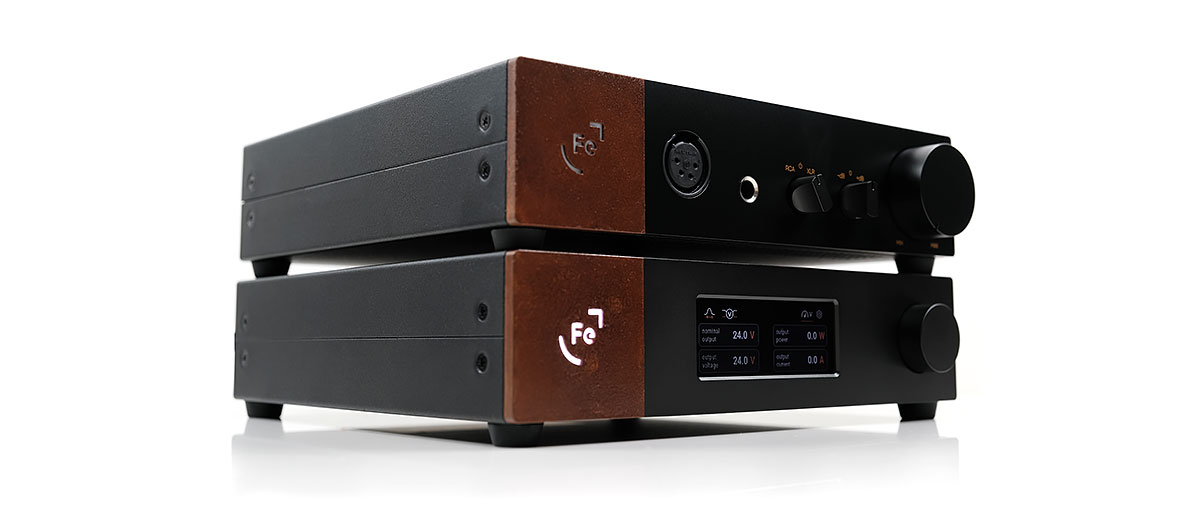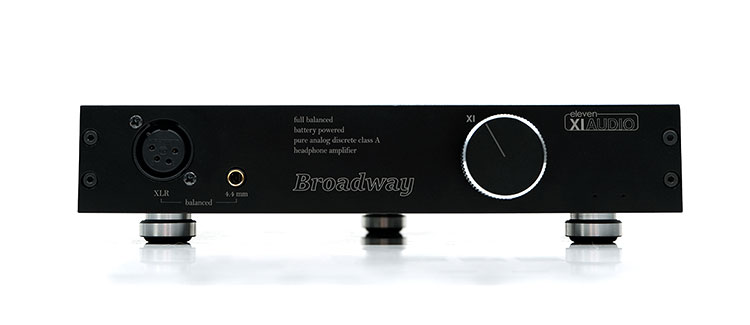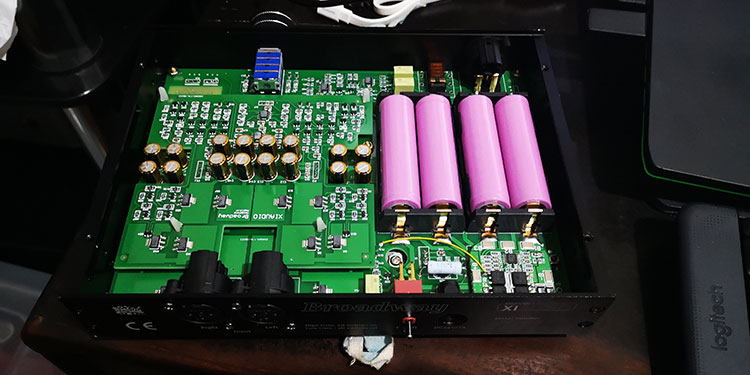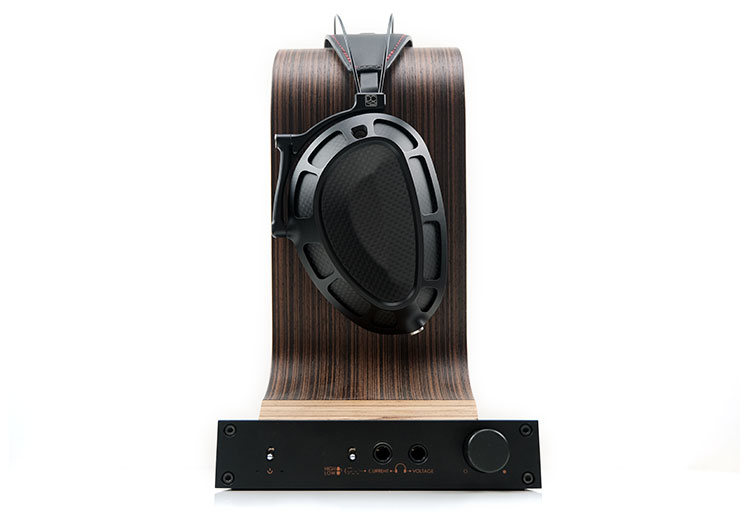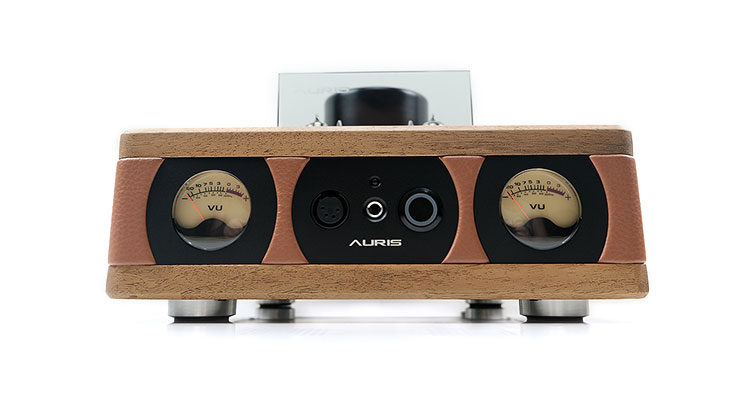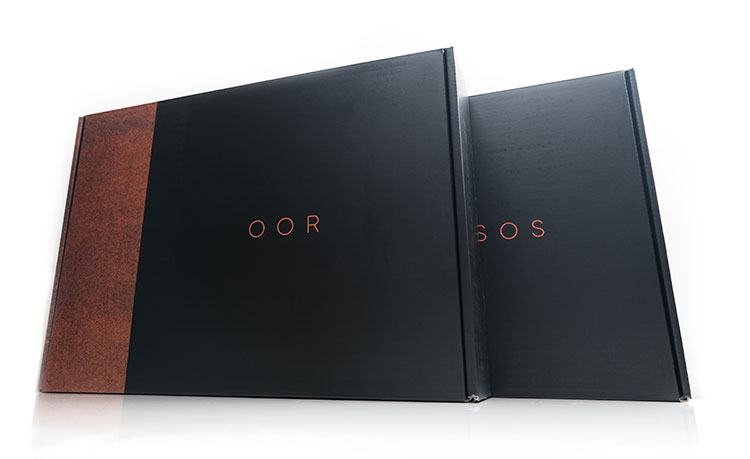Select Comparisons
All comparisons were completed using a Gustard X16 and Chord Electronics Qutest DACs and FLAC up to 192k from a PC source and Qobuz streaming via USB.
Xi Audio Broadway
$2299
Technical
The Broadway comes in at a slightly higher price than the OOR and it also has its own unique but very different power supply system. The Broadway actually comes in two versions, a single-ended and balanced variant of which we have the balanced version here.
Like the OOR power amp stage, Broadway is fully discreet but instead of a modified Class AB topology, it uses a Class-A circuit. It has a set of dual XLR to the rear and a balanced 4-pin XLR output at the front as well as a 4.4mm Pentaconn PO.
The OOR is also fully balanced but can handle SE at the same time so it has the more traditional 3-pin XLR balanced and 6.35mm SE output though no 4.4mm option. Instead, it can dual as a preamp with fixed or variable volume control.
Despite not having a like-for-like comparison of output power at 32Ω the OOR is likely to be more powerful given its peak voltage rating is 8W at 60Ω balanced compared to 1.5W 32Ω for the Broadway. ORR’s SE at 2W into 60Ω would probably be closer to Broadway’s peak voltage capability.
Both devices have gain control, the Broadway is dip-switch controlled at the base with a 10 dB low gain and 16 dB high gain option. The OOR has 3 gain settings but 6 in total if you include the SE values at -4 dB, +6 dB, or +16 dB balanced, and -10 dB, 0 dB, and +10 dB single-ended.
Design
The Broadway is marginally smaller at 21cm x 15.6cm x 4.5cm compared to the OOR’s 21.7 x 20.6 x 5cm and almost half the weight at 1.1k versus 1.8 kg. If you are considering using the HYPSOS with the Broadway it is very stackable with no overhang. Sadly, there is no preset for Xi Audio so you will have to manually configure it for the Broadway.
Aesthetically, the OOR is way more refined looking. Though both have industrial lines and compact panel boxes the Broadway has a touch of the DIY about it with more exposed screws to the front panel, the dip switching gain controls on the base, and sharper edges and cornering to the panel work.
The OOR’s corten steel rear and aluminum panel with that dash of rough-textured terracotta accenting to the left make for a complete and more professional look. The edging or corning is smoother, it feels more solid albeit heavier, and the 4 rubber feet are more stable than the tripod feet of the Broadway.
The big bonus of Broadway is the quad-replaceable 18650 lithium battery PSU alternative to its DC power supply. It makes the Broadway transportable as well as benefits from a cleaner power source compared to mains.
The OOR is still dependent on DC but with the HYPSOS it also gets a very clean and configurable power supply. You do have to watch what battery you put into the Broadway also. The cheap 18650s with a lower ampere rating will suck the dynamics of the performance. I recommend Molicel, Samsung T series, or Sony Greens for optimal performance.
Performance (Stock DC Power)
For this pairing and comparison, I decided on the easy-to-drive Meze Elite. There is a fair old gap between the Broadway and the OOR when using balanced outputs so it is fairly safe to say the 6-8W OOR is your choice for powering headphones like the Susvara compared to the 1.5W Broadway.
With the Elite, it should sound optimal on both allowing me to focus on how both are tuned and perform differently.
The Broadway is the airier and lighter-bodied of the two headphone amps. Whereas the OOR is the more physical and weighted alternative with a midrange that is neutral in imaging but thicker and richer in coloration. You get a very firm and physical mid-bass bump from the Elite from the OOR whereas the Broadway bass is faster but lighter-bodied.
Another key difference here is the treble of the Elite when paired with the two amps. It sounds peppier and more energetic on the Broadway but not quite as refined as the OOR/Elite pairing. That gives the Broadway/Elites mids timbre a bit of a sweeter overtone whereas on the OOR it’s more evenly balanced, and comparatively denser sounding.
The final detail is the resolution and background, which sounds blacker with the OOR despite the Broadway offering the airier presentation.
The imaging on the Broadway expanded quite wide and high but at the same time felt a bit more diffuse. The OOR might be the more intimate and weighted presentation but the layering and the accuracy of the imaging with the Elite was more convincing.
Performance (HYPSOS)
With HYPSOS the OOR sounds more precise with better microdynamics compared to the Broadway. Any hint of softness with the stock DC is replaced with a very vibrant and energetic performance. The slam on the low-end with the Elite is superb with an even better definition and the perception is of a much faster transient response.
The overall tuning bias has not changed a huge amount between these two. The Broadway still sounds the airier and slightly brighter amplifier but its dynamic range is not as quite as convincing as the OOR/HYPSOS combo. That lack of absolute precision in spatial note placement is now even more glaring.
The OOR soundstage with HYPSOS is still more on the rounded side for me with the Elite and not as ‘shimmery’ but it scaled beautifully sounding cleaner and more holographic compared to the stock DC cable sound, (and the Broadway).
Bakoon HPA-01
$1795 (discontinued)
Technical
The Bakoon HPA-01 is perhaps one of my favorite compact desktop headphone amplifiers for planar headphones but sadly discontinued. Like the OOR, it is also a compact desktop amplifier with a unique power supply implementation.
This is a current mode single-ended amplification circuit though Bakoon does provide the option to switch between current and voltage depending on your requirements. Current mode amplification tends to heavily favor low impedance or impedance agnostic planar headphones that tend to perform better in an analog circuit’s current domain.
The HPA-01A is also a single-ended only topology for both signal input and PO output though you can switch between voltage and current modes at the PO depending on your preference or requirements. The OOR is the more flexible here for balanced and single-ended PO as well as offering preamp duties which the Bakoon does not have.
The OOR also massively outguns the HPA-01 in terms of raw power with its ceiling of 8w into 60Ω when going balanced. However, the OOR’s 2W into 60Ω SE rating when calculated down to 32Ω is likely to be even or lower than the HPA-01’s 1W into 50Ω load capability.
Design
The HPA-01 is much more compact, slimmer, and lighter compared to the OOR. It is slightly deeper though but in all other aspects, this is like an iPad Pro versus an iPad Mini in terms of dimensions.
The aesthetics on the Bakoon do not have as much visual pop as the OOR with an all-black aluminum alloy design but the machining is excellent and on par with the OOR IMHO. The only drawback for me is the switches to the front which while functional are a little stiff and noisy to operate and do not feel as premium as the OOR dial selectors.
Since this is SE only there are no balanced in or outs with just a single dual RCA to the rear and dual SE to the front. You also do not get any gain control with the HPA-01.
The OOR will give you both balanced inputs and outputs as well as SE and the preamp balanced outputs. The dual SE of the HPA-01 allows you to switch from voltage to current and both will tweak the sound signature as a result.
Like the OOR, the power supply is not your normal DC and not much else. In fact, the HPA-01 uses a built-in battery supply rated at up to 10 hours. The DC input is for charging that battery rather than the unit running from mains power.
Like the Broadway, that gives the HPA-01 a very transportable profile, something which the OOR does not offer. Instead, you have HYPSOS which cleans up that DC input and keeps everything very stable including being able to tweak the sonic signature of the OOR.
Performance (Stock DC power)
Testing was done with a Dan Clark Audio Stealth which was picked specifically for its load demand and sometimes picky pairing with amps. I normally look for how well the low-end is fleshed out as an indicator of a good match.
In this case, the HPA-01 current mode was the lightest in terms of bass weight with its voltage mode alternative output injecting a bit more physicality and presence on the Stealth low. The OOR on the other hand sounded smoother but extended deeper and was the weightiest of the three potential tuning signatures.
The HPA-1 really came alive on staging width sounding the cleaner and brighter of the two amps, more so using current mode. Vocal presence was also sounded vibrant and further forward for imaging in comparison to the OOR.
Current mode with Stealth delivered some excellent treble which in turn imbued spatial information with a bit of an odd-harmonic lift. A very easy pairing to pick out for imaging cues from the mids upwards with the Stealth but not one for depth and power.
The Bakoon Voltage mode does produce a more holographic dimension and better low-end extension but slows it down a little in terms of perceived transient response.
In comparison, the OOR vocal imaging was more neutral with a smoother timbre, perhaps a slight bias to the fundamental also but not a huge amount. The instrumental timbre also sounded a little smoother and weightier with less of a treble influence and more neutral to slightly even-harmonic balance.
Performance (HYPSOS)
The Stealth/OOR pairing combined with the HYPSOS gets a lift in both dynamic range and treble clarity. In short, it sounds a little cleaner and roomier with more snap to the low-end and less of the attack softness from the regular OOR supply.
Of the two HPA-01 sound signatures, the voltage mode is going to be the most competitive to the OOR when combined with HYPSOS. It does very well with dynamic range and it also produces a similarly healthy bass response and speed from the Stealth.
The HPA01 voltage mode still images a little further forward than the OOR with HYPSOS which seems dead neutral to me overall. Voltage mode is also still the slightly brighter of the two in terms of midrange timbral coloration.
The current mode sounds a little too shallow and flat by comparison to the OOR/HPSOS combo using SE. I like the speed it generates but your listening attention is more to the mids and highs whereas the OOR/HYPSOS combo is more holographic and deeper sounding.
Auris Audio HA-2SF
$2499
The HA-2SF is a superb update on the original HA-2SE tube amplifier first launched in 2018. You can find our full review here. It is not Auris Audio’s flagship tube headphone amplifier but it also has its own unique power supply and a price not that far off the OOR also.
Technical
The HA-2SF is a SET or tube headphone amplifier as opposed to solid-state or resistor-based but like the OOR it also has preamp output capability. The stock tube configuration consists of four JJ Electronic ECC99 power tubes and a single input tube ECC82 tube.
Although the HA-2SF offers 3-pin XLR inputs and outputs it is actually a single-ended internal circuitry meaning these are for termination choices rather than offering a balanced option. The OOR is fully balanced and discreet with a Class AB circuitry, with both SE and balanced input and output options.
In terms of raw output power, the OOR will give you a lot more headroom when in balanced mode at up to 8W into 60Ω. The HA-SF’s lack of balanced output means it has a top-level 2W into 32Ω output capability which is actually on par with the OOR’s equivalent SE spec.
Of course, being a tube amp the noise and distortion performance of the HA-2SF does not measure as well with a THD+N of 2% at 2W and less than 1% at 1W compared to the very quiet and clean 0.0003% rating of the OOR.
Of course, that’s not a number that people base their buying preferences on when testing tube amps and in some ways, distortion is part of the unique sound signature of tube amps.
Both amps do use gain stages though the HA-2SF is just low and high whereas the OOR has 3-stage gain with different values for balanced and unbalanced.
What makes the HA-2SF quite unique though is the impedance selector which ranges from 32Ω to 600Ω in 2 stages. Like the HYPSOS SST, this can flavor the performance of your headphones by quite a bit in terms of dynamics.
Design
As much as I admire Ferrum’s approach to the corten/aluminum materials and aesthetics of the OOR, (including the HYPSOS), it really cannot compete with the stunning HA-2SF leather and wood combination.
Tube amps always have a more grandiose visual appeal compared to most resistor-based amplifiers but even most tube amps would struggle to look as beautiful as the Auris creation. Throw in dual VE meters and some LED lighting when powered up and the HA-2SF pretty much becomes the eye candy of any system.
However, the HA-2SF is far bigger and heavier so you do need a dedicated and fairly sizeable space to place it whereas the OOR is much more compact and stackable. These two might appeal to very different audiences on that basis.
I/O is a little different also and this is one of the areas I love about the HA-2SF with its ability to handle up to 3 different SE source inputs at the same time with a dial switch to control them. You can connect 2 with the OOR and control them also but one is balanced and the other unbalanced so not as handy for comparing source performances.
The HA-2SF’s PSU is a dedicated external linear power supply via a DC coupler connection. Granted, the OOR can couple with the HYPSOS for some very clean and well-controlled DC input, however, on its own, it uses a standard switchable external power supply.
However, the HA-2SF PSU is not as complex as the HYPSOS, it does not have any configuration controls beyond switching between a high voltage and a low voltage. However, it is free whereas the HYPSOS will set you back another 4-figure sum on top of the OOR.
Performance (Stock DC power)
For this pairing I went with the LCD-5 as this is a pairing for both amps that I am very familiar with and used extensively during the LCD-5 review a few months previously.
Neither amp has an issue in terms of driving the LCD-5 though bear in mind that going balanced with the OOR will give you a lot more voltage headroom compared to the HA-2SF which is 2W only SE.
In terms of coloration and timbre, the OOR is the cleaner and more neutral sounding of the two amps. The HA-2SF delivers a deeper and more powerful bass response as well as a richer instrumental and vocal timbre. The OOR low-end is tighter and more articulate, not a really surprising outcome when it comes to solid-state versus SET.
The HA-S2F is not a hugely warm tube amp but there is a slightly softer attack and a longer decay that delivers a more euphonic vocal tone and keeps the energetic LCD-5 mids largely in check. Paired with the ORR, the LCD-5 can tip slightly to the brighter side with a shaper partial overtone on hi-hats, synth notes, and some higher-pitching vocals.
Here I would suggest mixing up your DAC pairing with the two amps to balance out the tonal signature with the LCD-5. A neutral and clean DAC will sound just that with the OOR and personally,
I prefer the LCD-5 with a slightly smoother sound from DACs such as the Musician Audio Pegasus or the Holo Audio Spring DAC 2.
Performance (HYPSOS)
The first thing I noticed with the HYPSOS/OOR combo was that LCD-5 upper mids performance which did not have the same bright overtone as the OOR alone. In fact, I thought the control was equally as good if not better than the HA-2SF’s harmonic balance over the same range.
The HA-2SF is still the weightier and slightly warmer of the two amplifiers on the low-end but this time the OOR/HYPSOS dynamic range and overall clarity throughout the FR is a step up.
The micro-detail and articulation through the mids and treble are very precise and also very revealing. DAC matching is still key here for me to get the OOR ‘singing’ just right.
The HA-2SF richness and euphonic timbre pair wonderfully well with the LCD-5 so I would pick this pairing purely on tonal synergy. However, I do think technically the OOR is the more transparent and resolving of the two amplifiers for referencing and detail freaks when the HYPSOS is let loose.
Our Verdict
The OOR on its own is a very good solid-state analog headphone amplifier. However, paired with the HYPSOS PSU it becomes a great amplifier.
It looks great also, solidly built, and compact enough for desktop environments and tight audiophile cubby holes. It is not as grandiose as say the Auris Audio HA-2SF tube map, but it does not need to be. This combo has got it where it counts, and that’s on the inside.
The synergy with headgear is just fantastic. The OOR on its own has tons of headroom for the most demanding headphones out there yet the fidelity and delicacy to handle IEMs with equal aplomb.
Throw in the HYPSOS backed by a good DAC and that already excellent headroom becomes infused with even better dynamic range and improved resolution.
I honestly was not expecting this fairly unassuming-looking combo to perform that well with headline acts such as the HIFIMAN Susvara and the Abyss Diana Phi. Just how wrong was I?
Ferrum OOR Specifications
- OOR Gain (dB): balanced -4 dB, + 6dB, +16 dB / single-ended -10 dB, 0 dB, 10 dB
- Operation: Fully balanced, proprietary discrete power amp technology
- Inputs: XLR, RCA, 2.5 mm DC connector center positive, proprietary 4-pin DC connector
- Outputs: Balanced 4-pin XLR, 6.35 mm jack
- Frequency Response: 20 Hz – 100 kHz 0.1 dB
- Output Power Single Ended: 400 mW into 300 Ω, 2 W into 60 Ω
- Output Power Balanced: 1.600 mW into 300 Ω, 8 W into 60 Ω
- THD + Noise: 0.0004%
- OOR Input Impedance: 94 kΩ
- Output Impedance Single Ended: 22 Ω on pre-amp
- Output Impedance Balanced: 44 Ω on pre-amp
- Output headphones Impedance: < 0.3 Ω
- Power Consumption: Idle <15 W
- Power Adapter: 100/240 V AC to 22-30 V DC
- Dimension (W x D x H) (In/cm): 8.6 x 8.1 x 2.0 inch / 21.7 x 20.6 x 5 cm
- Weight (kg/lbs): 1.8 kg / 3.97 LBS
Ferrum HYPSOS Specifications
- Power input: 110-120 & 220-240V AC/50-60Hz (EU/US Version)
- 90 – 110Vac/50-60Hz (JP Version) IEC C14 power inlet, a fuse holder with power on/off switch plus two-stage EMI filter for low impedance load with better noise attenuation in low-frequency applications
- Mains cable: US/EU/UK
- DC OUT cable: 5×2.5mm DC plug / 5×2.1mm DC plug Custom cables made to order at additional cost
- Output Voltage Range: 5-30 [V]
- Max Continuous Output Current (for V_out below 13,3V): 6 [A]
- Max Continuous Output Current (for V_out higher than 13,3V): l_out= 80[W] / DCout[V]
- Maximum Impulse Current: 9A
- Maximum Impulse Power: DC V_out*9A (270W for 30V)
- Max Continuous Output Power (for V_out below 13,3V): P_out = V_out[V] * 6[A]
- Max Continuous Output Power (for V_out higher than 13,3V): 80W
- Dimensions (without knob, feet and connectors) (W x D x H , mm / inches): 217.5 x 206.5 x 50.0 / 8.6 x 8.1 x 2.0
- Net weight (kg/lb): ~ 2,89 / ~ 6.2
- Primary winding fuse: IEC 5x20mm, 250V 3.15A, slown-blown for Japan version / 250V 2A, slown-blown for Europe, US version
- Secondary winding fuse: Littefuse 154004T, 4A
- Power consumption: 230VAC, 50Hz @ 12VDC out/: Idle – 6VA @ 15W load – 30,7VA @ 60W load – 98VA @ 80W load – 133,9VA




